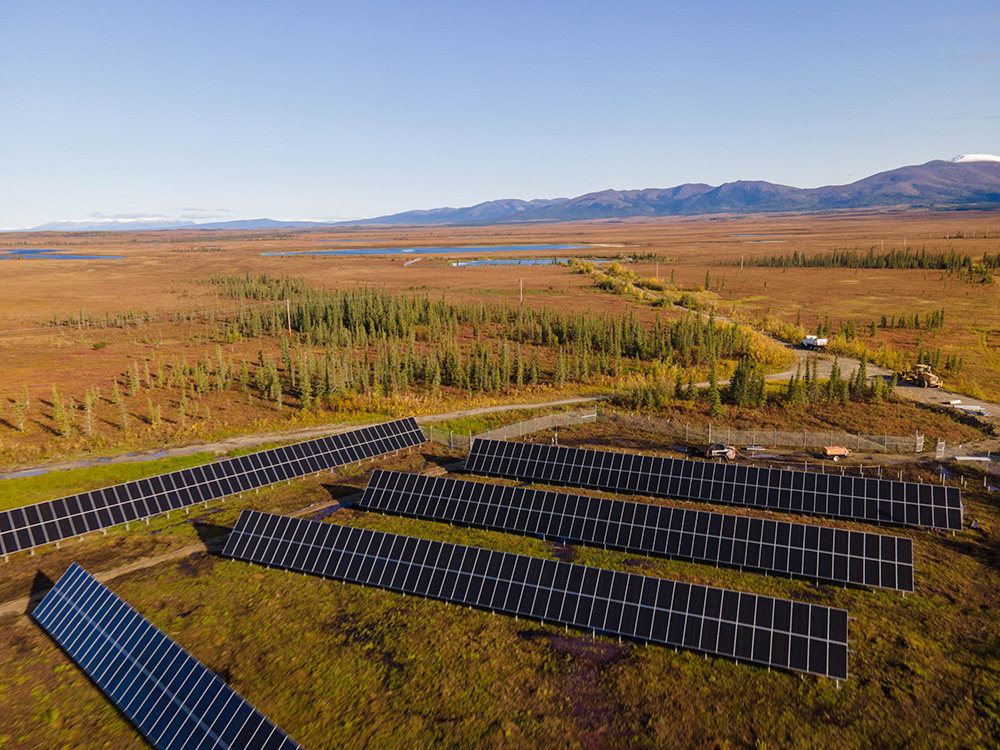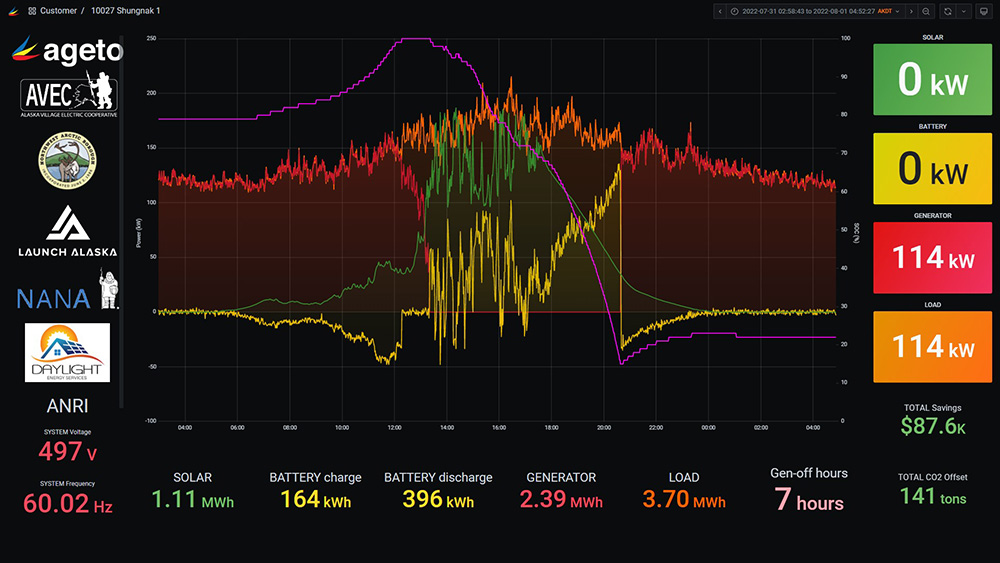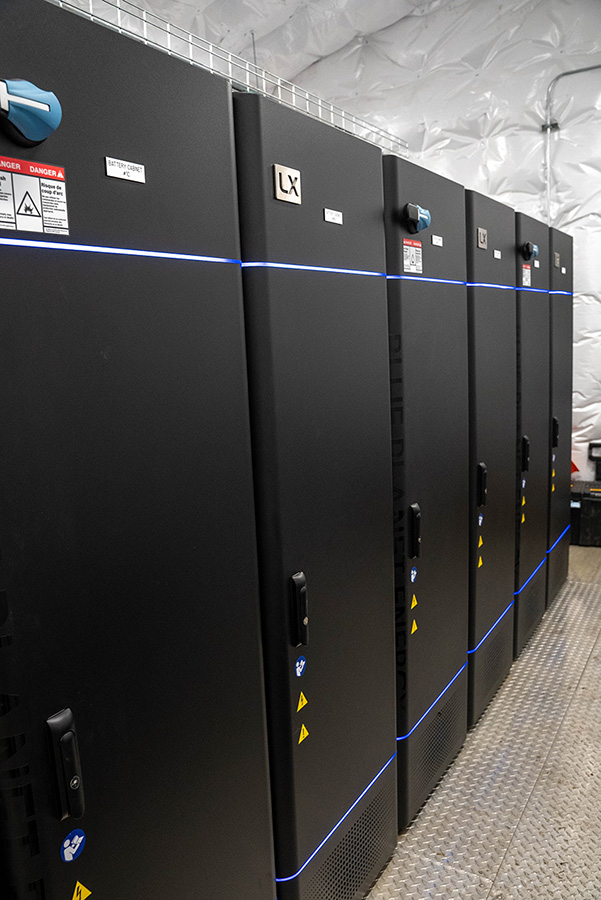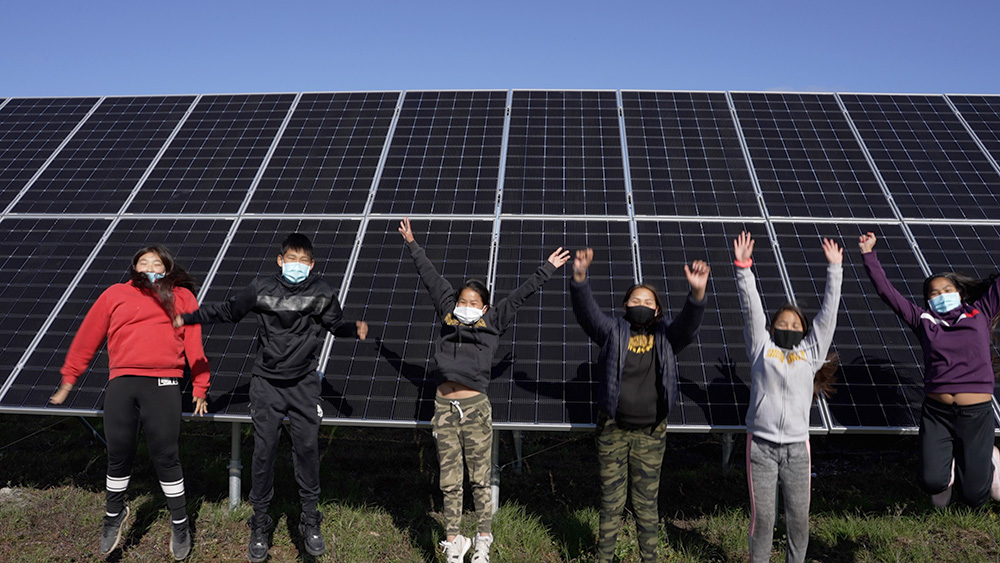
In remote northwestern Alaska above the Arctic Circle, the Iñupiat town of Shungnak and its connected sister village of Kobuk, 10 miles upstream, benefit economically from a new microgrid project. Commissioned in late 2021 and now operating successfully, the development team used UL Solutions HOMER® Pro to model the microgrid.
The villages expect to reduce their combined diesel fuel consumption by 25,000 gallons per year. Considering recent increases in diesel prices, Shungnak and Kobuk stand to save more than $200,000 in annual fuel costs, according to the Anchorage Daily News. With no roads connecting to Shungnak, the town depends on barge deliveries of diesel fuel in the summertime. But when the Kobuk River water levels are too low for barge travel, diesel is delivered by air, increasing the cost to over $10 per gallon.
Shungnak and Kobuk are not connected to the power grid and have traditionally used diesel generators to provide electricity. The 450 village residents depend primarily on subsistence hunting and fishing for their economic well-being. The new microgrid will provide energy cost reductions and essential improvements in power reliability and environmental quality, reducing carbon emissions and other types of pollution.
Shungnak microgrid tests solar, storage and a new business model
Alaska Native Renewable Industries (ANRI) designed and installed the Shungnak microgrid. They did this in collaboration with Alaska Village Electric Cooperative (AVEC) — Shungnak’s local utility and the largest electric utility in rural Alaska — and Launch Alaska, a non-profit organization working to mitigate climate change through the introduction of renewable energy technologies in Alaska. The Shungnak microgrid features a 233-kilowatt (kW) solar photovoltaic (PV) system, 384-kilowatt hours (kWh) of battery storage using lithium ferrous phosphate batteries, three generators and a control system designed and managed by Ageto Energy.
Because of its location north of the Arctic Circle, the PV array has an unusual configuration — the south-facing solar rows typical in PV installations are combined with a west-facing row that catches the northern afternoon sun.
According to Ageto Energy Application Engineer Laura Williams, about 30% of the two towns’ total load can be met by solar in the summer. But there’s relatively little solar in the dead of winter.

“In this project, we used HOMER Pro to model how much excess energy could be used to charge the batteries. If we had oversized the system, we would have had to curtail more of the solar during the summer,” Williams said. “HOMER helped us determine the optimal sizes for the lowest-cost microgrid.”
Williams explained that Ageto control system algorithms function locally, but the company monitors the microgrid remotely from Fort Collins, CO. The Ageto controls manage the various energy systems, balancing solar PV, batteries and generators, deciding which system should provide power at a specific moment and preventing them from interfering with each other.
According to Williams, what’s unusual about the Shungnak system is that the diesel engines and the batteries’ inverter are grid-forming. That means they generate a consistent voltage and frequency that allows one energy resource to replace another seamlessly. If the diesel engine powering the community trips offline, the batteries automatically take over without even a momentary flicker.
The microgrid and its battery system power Shungnak with a first-ever ‘diesel off’
The combination of a grid-forming inverter and a sufficiently sized solar array allows Shungnak to shut off the diesel engines entirely for several hours during long summer days, according to data from Ageto Energy.
Villagers relish the quiet that comes without the constant drone of diesel generators. Shungnak resident and local school principal Roger Franklin noted the community would have to get used to the lights being on even when the diesel generators are off.
“This is like a new world,” Franklin said.
Solar PV arrays are rare in Alaska, and adding energy storage to the microgrid is a first for the local utility, according to AVEC CEO Bill Stam. Stam said the utility has hesitated to invest in storage in the past. But the battery system proposed by Blue Planet Energy enabled AVEC to reconsider.

“This battery technology is, I think, probably the best chemistry or technology that’s available for rural communities,” Stam said.
“We haven’t had energy storage on any of our community plants before,” AVEC engineer Aimie Morgan said, calling the decision to move forward “a game changer” for AVEC.
The batteries from Blue Planet Energy use lithium ferrous phosphate (LFP) chemistry. While operating at a slightly lower energy density, LFP batteries last longer and are less likely to experience thermal runaway events than the more common lithium nickel manganese cobalt (NMC) batteries, reported Utility Dive. Because they do not contain cobalt, LFP batteries are also less toxic. According to the U.S. Centers for Disease Control, cobalt can be harmful to human health.
Wes Kennedy, senior sales application engineer for Blue Planet Energy, explained that the company also adds a highly efficient battery management system with independent controls for charging and discharging. Kennedy said since all lithium batteries are sensitive to the cold, the batteries operate in a heated building. Despite slightly higher upfront costs, Shungnak’s disposal costs will be lower when the batteries are decommissioned in 15-20 years. Overall, he says, the LFP batteries represent the most efficient and cost-effective choice for Shungnak.
Alaska’s statewide renewable energy outlook shows promise

Currently, Alaska generates about 50% of its electricity with natural gas, according to the U.S. Energy Information Administration (EIA). But the state also harnesses its abundant renewable energy resources. EIA reported that hydropower generates about 90% of Alaska’s renewable electricity, and approximately 60 MW of wind provides power in the coastal areas with remote microgrids, usually integrated with diesel backup. More recently, investments in solar energy are increasing, as construction on the state’s largest solar array gets underway in the town of Houston, AK. It will nearly double Alaska’s solar output, according to the Anchorage Daily News.
“The Shungnak microgrid rounds out Alaska’s clean energy portfolio,” Peter Lilienthal, UL Solutions global microgrid lead and the creator of HOMER software, said. “Southern Alaska has great hydropower, western and coastal Alaska have great wind, but the Shungnak microgrid demonstrates that batteries enable economically sustainable solar anywhere — even above the Arctic Circle. Running the microgrid with diesel generators turned off is when substantial savings kick in.”
*Editor’s note: We have updated the article headline to state that the Shungnak microgrid is “one of” Alaska’s first solar microgrids above the Arctic Circle.
We heard from readers about other microgrids above the Arctic Circle in Alaska and Canada — including some with solar. Over the years, we have written about a number of microgrids above the Arctic Circle. For example, you can read about the Yukon’s Old Crow microgrid in our 2018 story and a follow-up article in October 2020, and a 2017 article on the Colville Lake microgrid in the Northwest Territories of Canada. The 2017 article also talks about the Kotzebue Electric microgrid in Alaska.

UL Solutions’ HOMER® Pro is the leading pre-feasibility design software for modeling microgrids, with more than 250,000 users in more than 190 countries. It provides engineering and financial analyses of remote, off-grid and grid-tied complex distributed energy systems, helping reduce financial risk for owners and developers. Learn more about HOMER Pro and download a complimentary trial.

It’s a shame that Robert W. Retherford is no longer with us as he would have been excited to see this technology today. I worked for him briefly in 1972 on electrification projects in Alaska. At that time he had been involved with design or construction of probably 90% of the systems around the state post WWII. As well as Alaska statehood. I throughly enjoyed working with him prior to my return to the Lower 48 to work for GE/NASA.
Thank you for sharing your perspective and history, Elo. We are glad you read the article!
I have seen solar installations south of the Antarctic Circle, and the panels were completely vertical (parallel to the ground). The reason being due to the low azimuth of the sun, coupled with the available energy to be realized as a result of reflection off of snow and ice. Is this not a consideration at this site?
Hi Joseph,
Yes you are correct. The designers have taken the low azimuth into account both in design and operation of the system.
Thank you for your comment,
Lili Francklyn
I will guess the cost to erect this micro grid is much more than if the structures had been sprayed on the exterior with foam insulation / waterproofing then hybrid wind / solar system installed to each structure solving the energy at the source of use. Now make each structure produce more energy than using creates a home generator.
Hi David,
Thank you for your comment. You bring up an important point about energy efficiency. I don’t know the cost comparison but there are other needs for power in the community aside from the individual homes. Also there are important economies of scale in building a system that can be shared by the whole community.
All the best,
Lili Francklyn